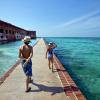A tour of the Camp Blanding Museum in Clay County begins here.
- Courtesy of Camp Blanding Museum
A variety of military rifles is on display at the Camp Blanding Museum in Clay County.
- Courtesy of Camp Blanding Museum
An ambulance on display at the Camp Blanding Museum in Clay County
- Courtesy of Camp Blanding Museum
An American tank on display at the Camp Blanding Museum in Clay County.
- Courtesy of Camp Blanding Museum
A jeep, a workhorse of the Allied war effort, on display at the Camp Blanding Museum in Clay County.
- Courtesy of Camp Blanding Museum
The memorial to Florida’s regiments at the Camp Blanding Museum in Clay County.
- Courtesy of Camp Blanding Museum
By Denise Maloof
An expedition into Florida’s northeastern woods reveals a Clay County gem.
Looming from forest and S.R.16 asphalt, the Camp Blanding Museum nestles outside the main gate of Camp Blanding, a historic North Florida National Guard installation that remains active and alive, filled with troops and their accoutrements.
One of the base’s 1940s-era guest barracks houses the North Florida military history museum, a two-story structure surrounded by massive World War II armament and sobering memorials.
Flowery hanging baskets swing from its entry porch, belying the seriousness within, and without.
But enter, admission-free, and re-appreciate freedom. You may be greeted by Joe Schiffer, a Brooklyn, N.Y., native and retired Navy veteran (1951-1979) from the museum’s volunteer corps. He mans the front desk this day, reciting statistics; among them, that Camp Blanding masqueraded as Florida’s fourth largest city during its World War II training height.
“I’m back where I started,” Schiffer said of launching his career at a Jacksonville naval base.
He provides other facts — Camp Blanding’s 1939 establishment as a Florida National Guard training site, carved from Clay County’s piney landscape around Lake Kingsley, a 10,000-year-old sinkhole, per assistant curator Jim Hughes.
Then trek through a trove of artifacts, photographs, weaponry and uniforms. A battlefield Jeep hulks in one display. Newspaper clippings describe German prisoners of war held here, including one ex-POW who journeyed back decades later, for a visit.
Most artifacts arrive via private citizens or service people with Camp Blanding ties. Eighty percent of the treasure overflowing upstairs storage came from civilians, Hughes says. But, not everything carries exterior provenance. Given Camp Blanding’s age, a recent cleanup of a base building prompted a phone call.
“In a back corner was an old World War II teletype machine,” Hughes remembered the caller saying. “‘Do you want it?’ And we said yes.”
Initially not excited — the museum has a teletype machine — he was shocked when the donation arrived. It required several men to haul it inside; a metal monstrosity.
“It was a dog-tag machine and we don’t have one of those,” Hughes said. “That was a find.”
On this afternoon, he cleaned other fresh donations arrayed on a conference table — an U.S. Air Force survival blade, a cut-down World War I bayonet from 1918, a British Army bayonet and old leather covers and scabbards. A Vietnam-era bayonet looked longer, blacker and evil.
“Sometimes it’s pretty quiet,” Hughes said of his and curator Greg Parson’s duty hours. “Then it rains and here they come.”
“They” are retired or active military families visiting Camp Blanding’s recreation area. Boy Scout and Cub Scout troops also camp on the base.
“They come in and the adults have this ‘help me,’ look on their faces,” Hughes said with a smile.
He has the antidote. After negotiating the museum, head outside to gawk at tanks, armored troop carriers, field ambulances and airplanes. Pause at memorials honoring Camp Blanding alumni.
When You Go...
Camp Blanding Museum and Memorial Park
5629 S.R. 16 West
Starke, Fla. 32091-9703
904-682-3196
campblandingmusem.org
Directions from Interstate 10: Take Exit 343 south to Starke. Turn left on S.R. 16 and head east for approximately eight miles. The Camp Blanding Museum will be on your right, outside the main gate.





























